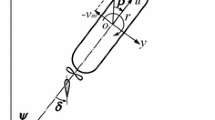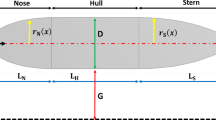Abstract
Resonance may occur when the periods of incoming waves are close to the eigen-periods of harbor basin. The amplified waves by resonance in harbor will induce serious wave hazards to harbor structures and vehicles in it. Through traditional theoretical approaches, the eigen-periods of harbor basin with regular shapes can be obtained. In our study, we proposed a numerical model to simulate the behavior characteristics of the harbor waves. A finite difference numerical model based on the shallow water equations (SWE) is developed to simulate incoming tsunami and tidal waves. By analyzing the time series data of water surface wave amplitude variations at selected synthetic observation locations, we estimate the wave height and arrival time in coastal area. Furthermore, we use frequency spectrum analysis to investigate the natural frequencies from the data recorded at the synthetic observation stations.
Similar content being viewed by others
References
Satake K. 28 Tsunamis. In: Lee W H K, Kanamori H, Jennings P C, et al, eds. International Geophysics. Academic Press, 2002. 437–451
Fukao Y. Tsunami earthquakes and subduction processes near deep-sea trenches. J Geophys Res, 1979, 84: 2303–2314
Kervella Y, Dutykh D, Dias F. Comparison between three-dimensional linear and nonlinear tsunami generation models. Theor Comput Fluid Dyn, 2007, 21: 245–269
Lynett P, Liu P L F. A numerical study of the run-up generated by three-dimensional landslides. J Geophys Res-Oceans, 2005, 110: C03006
Saito T, Furumura T. Three-dimensional simulation of tsunami generation and propagation: Application to intraplate events. J Geophys Res, 2009, 114: B02307
Greenslade D, Titov V. A comparison study of two numerical tsunami forecasting systems. Pure Appl Geophys, 2008, 165: 1991–2001
Kirby J T, Dalrymple R A. An approximate model for nonlinear dispersion in monochromatic wave propagation models. Coastal Eng, 1986, 9: 545–561
Titov V V, Gonzalez F I, Bernard E N, et al. Real-time tsunami forecasting: Challenges and solutions. Natural Hazards, 2005, 35: 41–58
Cavaleri L, Alves J, Ardhuin F, et al. Wave modelling—The state of the art. Prog Oceanogr, 2007, 75: 603–674
Escher J. Wave breaking and shock waves for a periodic shallow water equation. Philos Trans R Soc A-Math Phys Eng Sci, 2007, 365: 2281–2289
Hamm L, Madsen P A, Peregrine D H. Wave transformation in the nearshore zone—A review. Coastal Eng, 1993, 21: 5–39
Li B. Wave equations for regular and irregular water wave propagation. J Waterway Port Coastal Ocean Eng-Asce, 2008, 134: 121–142
Huang H. A review of coastal wave modeling. Adv Mech, 2001, 31: 592–610
Group T W. The WAM Model. A third generation ocean wave prediction model. J Phys Oceanogr, 1988, 18: 1775–1810
Komen G J, Cavaleri L, Donelan M, et al. Dynamic and Modelling of Ocean Waves. Cambridge: Cambridge University Press, 1994
Okada Y. Surface deformation due to shear and tensile faults in a half-space. Bull Seismol Soc Am, 1985, 75: 1135–1154
Koh H L, Teh S Y, Liu P L F, et al. Simulation of Andaman 2004 tsunami for assessing impact on Malaysia. J Asian Earth Sci, 2009, 36: 74–83
Titov V V, Synolakis C E. Extreme inundation flows during the Hokkaido-Nansei-Oki tsunami. Geophys Res Lett, 1997, 24: 1315
Imamura F, Shuto N, Goto C. Numerical simulations of the transoceanic propagation of tsunamis. In: Proceedings of the Sixth Congress Asian and Pacific Regional Division, IAHR. Kyoto, Japan, 1988. 265–272
Liu P L F, Woo S B, Cho Y S. COMCOT User Manual Version 1.6. 2007
Fujii Y, Satake K. Tsunami source of the 2004 Sumatra-Andaman earthquake inferred from tide gauge and satellite data. Bull Seismol Soc Am, 2007, 97: S192–S207
Satake K. Inversion of Tsunami waveforms for the estimation of heterogeneous fault motion of large submarine earthquakes: The 1968 Tokachi-oki and 1983 Japan sea earthquakes. J Geophys Res, 1989, 94: 5627–5636
Baba T, Cummins P R, Hori T, et al. High precision slip distribution of the 1944 Tonankai earthquake inferred from tsunami waveforms: Possible slip on a splay fault. Tectonophysics, 2006, 426: 119–134
Geist E L, Titov V V, Arcas D, et al. Implications of the 26 December 2004 Sumatra-Andaman earthquake on tsunami forecast and assessment models for great subduction-zone earthquakes. Bull Seismol Soc Am, 2007, 97: S249–S270
McWilliams J C. Fundamentals of Geophysical Fluid Dynamics. Cambridge: Cambridge University Press, 2006
Yee H C, Warming R F, Harten A. Implicit total variation diminishing (TVD) schemes for steady-state calculations. J Comput Phys, 1985, 57: 327
Brezina M, Falgout R, Maclachlan S, et al. Adaptive smoothed aggregation (SA). Philadelphia, PA, ETATS-UNIS. Soc Ind Appl Math, 200, 25: 1896–1920
Adams M F. Algebraic multigrid methods for constrained linear systems with applications to contact problems in solid mechanics. Number Linear Algebra Appl, 2004, 11: 141–153
Wei Y, Mao X Z, Cheung K F. Well-balanced finite-volume model for long-wave runup. J Waterway Port Coastal Ocean Eng, 2006, 132: 114–124
Piatanesi A, Lorito S. Rupture process of the 2004 Sumatra-Andaman earthquake from tsunami waveform inversion. Bull Seismol Soc Am, 2007, 97: S223–S231
Liu Y, Santos A, Wang S M, et al. Tsunami hazards along Chinese coast from potential earthquakes in South China Sea. Phys Earth Planet In, 2007, 163: 233–244
Palma E D, Matano R P. Dynamical impacts associated with radiation boundary conditions. J Sea Res, 2001, 46: 117–132
Marchesiello P, McWilliams J C, Shchepetkin A. Open boundary conditions for long-term integration of regional oceanic models. Ocean Model, 2001, 3: 1–20
Carter G S, Merrifield M A. Open boundary conditions for regional tidal simulations. Ocean Model, 2007, 18: 194–209
Zhang H, Shi Y L, Yuen D A, et al. Modeling and visualization of tsunamis. Pure Appl Geophys, 2008, 165: 475–496
Snieder R. A Guided Tour of Mathematical Methods. 2nd ed. Cambridge: Cambridge University Press, 2004
Stoneley R. The propagation of tsunamis. Geophys J R Astron Soc, 1964, 8: 64–81
Author information
Authors and Affiliations
Corresponding author
Rights and permissions
About this article
Cite this article
Jing, H., Zhang, H., Yuen, D.A. et al. Numerical analysis of wave hazards in a harbor. Sci. China Earth Sci. 55, 1554–1564 (2012). https://doi.org/10.1007/s11430-012-4388-1
Received:
Accepted:
Published:
Issue Date:
DOI: https://doi.org/10.1007/s11430-012-4388-1




